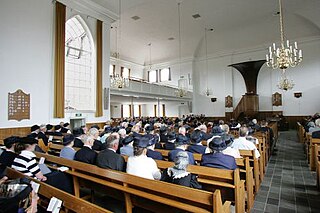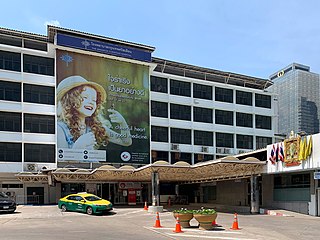It has been suggested that this article be merged with Christian mission . (Discuss) Proposed since August 2021. |

A religious mission or mission station is a location for missionary work, in particular a Christian mission.
It has been suggested that this article be merged with Christian mission . (Discuss) Proposed since August 2021. |

A religious mission or mission station is a location for missionary work, in particular a Christian mission.

Historically, missions have been religious communities used to spread belief in Christianity to local indigenous populations. Missions often also had charitable functions: providing medical help, food, shelter and clothing to those who asked for it, and secular as well as religious education. Funding for missions was provided from donations from individuals within the sponsoring denomination, possibly augmented by local, regional or state government.
Catholicism's support for the Spanish missions in the Americas played a key role in the Spanish colonization of the Americas. Catholic mission communities commonly consisted of churches, gardens, fields, barns, workrooms, dormitories, and schools. They were often located near a good water supply to support the local population.
Christian missions in Australia played a part in both indoctrinating Aboriginal Australians into Christianity [1 1] , and in controlling their movements and removing children from families, leading to the Stolen Generations. German missionaries ran Lutheran and other mission stations and schools, from the earliest days of colonisation of Australia. One of the largest organisations was the United Aborigines Mission, which ran dozens of missionaries and stations in Western Australia, New South Wales and South Australia in the 1900s.
During the time of the Holland (Batavia) Mission (1592–1853), when the Roman Catholic church in the country was suppressed, there were neither parishes nor dioceses, and the country effectively became a mission area in which congregations were called "stations" (staties). Statie, usually called a clandestine church in English, refers to both the congregation's church and its seat or location.

The Jesuit missions among the Guarani were a type of settlement for the Guaraní people in an area straddling the borders of present-day Paraguay, Brazil, and Argentina. The reductions were established by the Jesuit Order of the Catholic Church early in the 17th century and wound up in the late 18th century after the expulsion of the Jesuit order from the Americas. The reductions have been called an experiment in "socialist theocracy" or a rare example of "benign colonialism". Detractors have said that 'the Jesuits took away the Indians' freedom, forced them to radically change their lifestyle, physically abused them, and subjected them to disease."

A Christian mission is an organized effort for the propagation of the Christian faith. Missions involve sending individuals and groups across boundaries, most commonly geographical boundaries, to carry on evangelism or other activities, such as educational or hospital work. Sometimes individuals are sent and are called missionaries. When groups are sent, they are often called mission teams and they do mission trips. There are a few different kinds of mission trips: short-term, long-term, relational and those that simply help people in need. Some people choose to dedicate their whole lives to mission. Missionaries preach the Christian faith, and provide humanitarian aid. Christian doctrines permit the provision of aid without requiring religious conversion. However, Christian missionaries are implicated in the genocide of indigenous peoples. Around 100,000 native people in California, U.S., or 1/3 of the native population, are said to have died due to missions.

Christianity is a minority religion in Malaysia. In the 2020 census, 9.1% of the Malaysian population identified themselves as Christians. About two-thirds of Malaysia's Christian population lives in East Malaysia, in the states of Sabah and Sarawak. Adherents of Christianity represent majority (50.1%) of the population in Sarawak, which is Malaysia's largest state by land area. The major Christian denominations in Malaysia include Roman Catholics, Anglicans, Baptists, Brethren, non-denominational churches, independent Charismatic churches, Lutherans, Methodists, and Presbyterians.

The Moravian Church, or the Moravian Brethren, formally the Unitas Fratrum, is one of the oldest Protestant denominations in Christianity, dating back to the Bohemian Reformation of the 15th century and the Unity of the Brethren founded in the Kingdom of Bohemia, sixty years before Luther's Reformation.

Christians in Bangladesh account for 0.30% of the nation's population as of 2022 census. Together with Judaism and Buddhism, they account for 1% of the population. Islam accounts for 91.04% of the country's religion, followed by Hinduism at 7.95% as per 2022 census.

Christianity in China has been present since at least the 7th century and has gained a significant amount of influence during the last 200 years. The Syro-Persian Church of the East appeared in the 7th century, during the Tang dynasty. Catholicism was among the religions patronized by the emperors of the Mongol-led Yuan dynasty, but did not take root until it was reintroduced in the 16th century by Jesuit missionaries. Starting in the early nineteenth century, Protestant missionaries attracted small but influential followings, and independent Chinese churches followed.

The Society of the Divine Word, popularly called Verbites or the Divine Word Missionaries, and sometimes the Steyler Missionaries, is a Catholic missionary religious congregation. As of 2020, it consisted of 6,023 members composed of priests and religious brothers working in more than 70 countries, now part of VITA international. It is one of the largest missionary congregations in the Catholic Church. Its members add the nominal letters SVD after their names to indicate membership in the Congregation. The superior general is Paulus Budi Kleden who hails from Indonesia.

A church is a religious organization or congregation that meets in a particular location. Many are formally organized, with constitutions and by-laws, maintain offices, are served by clergy or lay leaders, and, in nations where this is permissible, often seek non-profit corporate status.

The Catholic Church during the Age of Discovery inaugurated a major effort to spread Christianity in the New World and to convert the indigenous peoples of the Americas and other indigenous peoples. The evangelical effort was a major part of, and a justification for, the military conquests of European powers such as Portugal, Spain and France. Christian Missions to the indigenous peoples ran hand-in-hand with the colonial efforts of Catholic nations. In the Americas and other colonies in Asia and Africa, most missions were run by religious orders such as the Franciscans, Dominicans, Augustinians, and Jesuits. In Mexico the early systematic evangelization by mendicants came to be known as the "Spiritual Conquest of Mexico".

Christianity in Ethiopia is the largest religion in the country, the Ethiopian community at large, and dates back to the early medieval Kingdom of Aksum, when the King Ezana first adopted the faith in 4th century AD. This makes Ethiopia one of the first regions in the world to officially adopt Christianity. Various Christian denominations are now followed in the country. Of these, the largest and oldest is the Ethiopian Orthodox Tewahedo Church an Oriental Orthodox church centered in Ethiopia. The Orthodox Tewahedo Church was part of the Coptic Orthodox Church until 1959, when it was granted its own patriarch by Coptic Orthodox Pope of Alexandria and Patriarch of All Africa Cyril VI. Ethiopia was the only region of northern Africa to survive the expansion of Islam as a Christian state.

Christianity is Indonesia's second-largest religion, after Islam. Indonesia also has the second-largest Christian population in Southeast Asia after the Philippines, the largest Protestant population in Southeast Asia, and the fourth-largest Christian population in Asia after the Philippines, China and India. Indonesia's 28.6 million Christians constituted 10.72% of the country's population in 2018, with 7.60% Protestant (20.25 million) and 3.12% Catholic (8.33 million). Some provinces in Indonesia are majority Christian.

Christianity was first introduced to Thailand by European missionaries. It represents 1.17% of the national population, which is predominantly Buddhist. Christians are numerically and organizationally concentrated more heavily in the north, where they make up an estimated 16% of some lowland districts and up to very high percents in tribal districts.

Christianity in Angola has existed since 1491. Today 80% of Angolans practise some form of Christianity.

Religion in Angola is diverse, with Christianity being the most widely professed faith. Roman Catholics constitute about half of the population. Other Christian denominations include Baptists, Methodists, Congregationalists, Lutherans, Reformed Churches and Seventh-day Adventists and Jehovah's Witnesses − all these denominations making up about a quarter of the population.

Religion in Vanuatu is dominated by various branches of Christianity. Vanuatu is an archipelago made up of 13 larger islands, and approximately 70 smaller surrounding islands, each home to multitudes of diverse cultural and religious communities. As of 2020, the population of approximately 300,000 people speak as many as 145 languages throughout the island nation. Approximately 82% of the population of Vanuatu is Christian. An estimated 28% is Presbyterian, 12% Roman Catholic, 15% Anglican, and 12% Seventh-day Adventist. Groups that together constitute 15% include the Church of Christ, United Pentecostal Church, Assemblies of God, Neil Thomas Ministries, the Apostolic Church and other Christian denominations.
Christianity is the largest religion in Nauru, with Nauru Congregational Church being the largest denomination, encompassing 35.71% of the population as of the 2011 census. Freedom of religion is a constitutional right, and the country's laws and society uphold this right without any significant breaches.

The Catholic Church in Latin America began with the Spanish colonization of the Americas and continues up to the present day.

Telugu Christians or Telugu Kraistava are a religious community who form the third-largest religious minority in the Indian states of Andhra Pradesh and Telangana. According to the Census of India, there are over a million Christians in Andhra Pradesh, constituting 1.51% of the state's population, although a decrease from the 1971 census figure which was 2%, as a result of low birth rates and emigration. Most Telugu Christians are Protestant, belonging to major Indian Protestant denominations such as the predominant Anglican Church of South India, Pentecostals such as Assemblies of God in India, India Pentecostal Church of God, The Pentecostal Mission, the Andhra Evangelical Lutheran Church, the Samavesam of Telugu Baptist Churches, the Salvation Army and several others. There also is a significant number of Roman Catholics and Evangelicals. Although the Franciscans of the Roman Catholic Church brought Christianity to the Deccan area in 1535, it was only after 1759 AD, when the Northern Circars came under the rule of the East India Company, that the region opened up to greater Christian influence. The first Protestant missionaries in Andhra Pradesh were Rev. Cran and Rev. Des Granges who were sent out by the London Missionary Society. They set up their station at Visakhapatnam in 1805 AD. Regions with significant populations of Telugu Christians include the erstwhile Northern Circars, the coastal belt and the cities of Hyderabad and Secunderabad. Telugu Christians have one of the highest literacy and work participation figures and most even male-to-female ratio figures among the various religious communities in the state.
Christianity and colonialism are often closely associated with each other due to the service of Christianity, in its various sects, as the state religion of the historical European colonial powers, in which Christians likewise made up the majority. Through a variety of methods, Christian missionaries acted as the "religious arms" of the imperialist powers of Europe. According to Edward Andrews, Christian missionaries were initially portrayed as "visible saints, exemplars of ideal piety in a sea of persistent savagery". However, by the time the colonial era drew to a close in the later half of the 20th century, missionaries became viewed as "ideological shock troops for colonial invasion whose zealotry blinded them", colonialism's "agent, scribe and moral alibi".

The Spanish missions in the Americas were Catholic missions established by the Spanish Empire during the 16th to 19th centuries in the period of the Spanish colonization of the Americas. These missions were scattered throughout the entirety of the Spanish colonies, which extended from Mexico and southwestern portions of the current-day United States to Argentina and Chile.